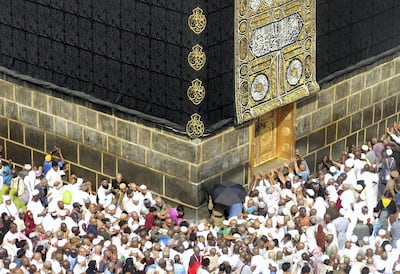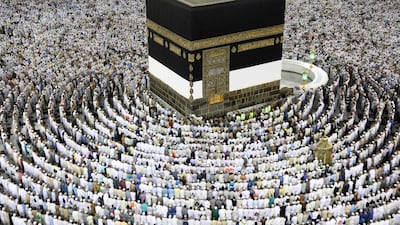Walking in the Great Mosque of Makkah, a smell begins to rise as you approach the Kaaba — but not the one some might expect.
It is perfume; thick and heady and coming from the black cube, also known as the House of God, in the centre of the mosque.
Said to be made from a sacred black stone and built by Prophet Ibrahim and his son, all Muslims face it when they pray.
It is the ornate silk cloth adorning the Kaaba, known as the Kiswah, which is responsible for the aroma.
Doors to the Kaaba open just twice a year for cleaning: 30 days before Ramadan and again 30 days before Hajj and the Kiswah is replaced annually on Dhu Al Hajjah 9, the day pilgrims visit Mount Arafat, where Prophet Mohammed is believed to have given his last sermon.

Made at King Abdul Aziz Complex for Kaaba Kiswah, the Kiswah is designed with Quranic verses that are hand-embroidered in threads of gold and silver. It weighs 670 kilograms and measures 658 square meters.
To speed up production, more than 200 artisans use computers to print designs and weave the Kiswah using the world’s largest sewing machine at 16 meters long.
Contributing towards the maintenance of the Kaaba is considered a great honour. Both kings and commoners have contributed towards dressing the Kaaba be it through funding the making of the Kiswah to sewing it.
The Kiswah is formed from 47 reels of cloths that are 14 metres long and 95 centimetres wide. The top third of the cloth is the Kiswah belt where the Quranic text is typically placed in a band circling the Kaaba.
The custom of incorporating woven, religious inscriptions into the cloth can be traced back to the 14th century. About 120kg of silver and gold are sewed into the cloth in the Al Thuluth style of calligraphy
These inscriptions typically praise and invoke Allah with the Shahada — the Islamic profession of faith.
“0h Allah, There is no God but Allah, Mohammed is the Messenger of Allah. The Most Loving, the Benefactor. Glory be to Allah and Praise be to Allah and Glory is to Allah the Great”.
Surat Al Ikhlas can be found embroidered at each corner of the Kaaba, beneath the belt. Six other verses are written in separate frames, alternating the following statements: “The most gracious, the most merciful”, “Oh you the alive, the self-subsisting”, or “praise to Allah”.
The ornate decorations covering the door to the Kaaba is designed with Quranic verses and is left open to reveal the black stone beneath it.
All four sides of the Kiswah are affixed to the ground using copper rings.
Though the black of the Kiswah has become iconic, it was not always the colour used. The Kiswah’s colour was changed during the reigns of different Caliphs and rulers.
During Caliph Al Ma’mun’s reign, the Kaaba was draped three times a year, each time with a different colour: red, white and red brocade. Later on, the colour switched to black and began to include more embroidery.
More than 200 artisans labour in a factory for months to produce the silk cover. The long process consists of several phases, beginning with dyeing of the silk black and then weaving. Previously, weaving was done by hand, but is now done mechanically.
Next, designs and verses are drawn and printed on to the black silk. The embroidery is the longest and most strenuous phase, done by hand. The finished product is dressing the Kaaba.
Every year, the old Kiswah is removed and cut into small pieces that are then distributed to certain individuals and organisations.


